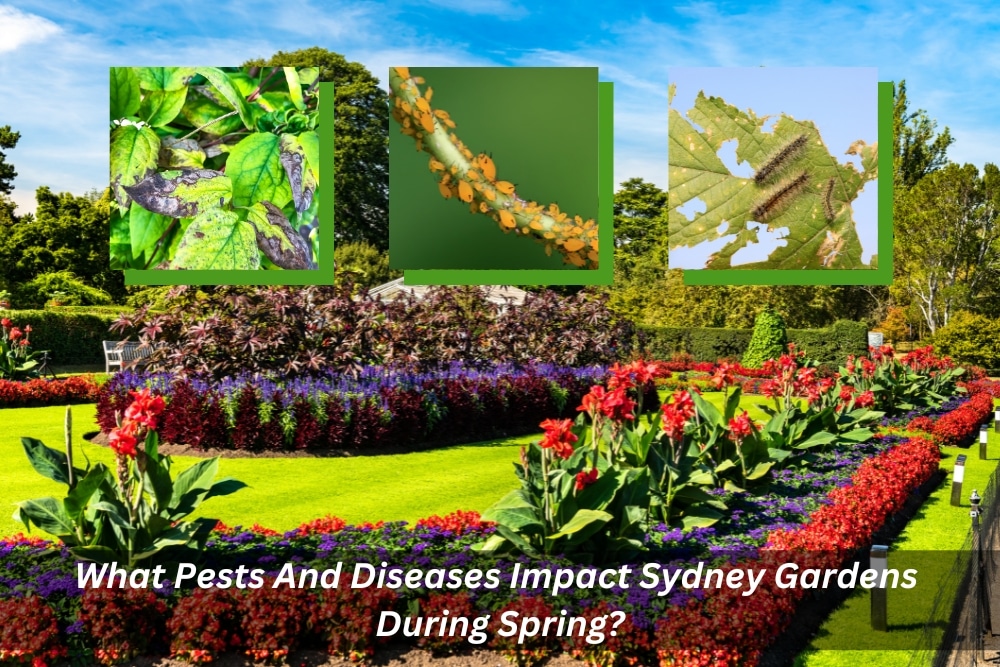Spring in Sydney is a beautiful time when gardens come to life with vibrant colours and lush greenery. However, it’s also a time when various pests and diseases can wreak havoc on your beloved garden. To ensure your garden thrives during this season, it’s essential to be aware of the common culprits that can threaten your plants.
Common garden pests in Sydney during spring
- Aphids: These tiny, soft-bodied insects love to feast on tender new growth. They can be green, yellow, or brown and often cluster on the undersides of leaves, sucking the sap from plants.
- Whiteflies: Whiteflies are small, white insects that can infest a variety of plants. They suck sap from leaves, leaving behind a sticky residue known as honeydew, which can attract sooty mould.
- Caterpillars: Various caterpillar species can damage your garden in spring. They chew on leaves and can quickly defoliate plants if left unchecked.
- Snails and slugs: These slimy creatures come out in the damp spring weather. They munch on young seedlings and leaves, leaving behind holes and damage.
Common garden diseases in Sydney during spring
- Powdery mildew: Powdery mildew is a common fungal disease in Sydney gardens during spring. It appears as a white, powdery substance on leaves, inhibiting photosynthesis and weakening plants.
- Downy mildew: Similar to powdery mildew, downy mildew is another fungal disease that affects plants in spring. It creates yellow or brown patches on leaves, causing them to wither and die.
- Leaf spot: Leaf spot diseases are caused by various fungi and bacteria. They manifest as dark, irregular spots on leaves, which can eventually lead to defoliation if not treated.
What are the signs and symptoms of garden pests and diseases?
Identifying the signs and symptoms of garden pests and diseases in your Sydney garden during spring is crucial for timely intervention.
Signs of garden pests
- Visible insects: If you notice clusters of tiny insects on your plants, such as aphids or whiteflies, it’s a clear sign of a pest infestation.
- Chewed leaves: Check your plant leaves for irregular holes, chewed edges, or signs of leaf damage, which are indicators of caterpillar or snail/snug activity.
- Sticky residue: The presence of sticky honeydew on your plant’s leaves is a sign that aphids or whiteflies are feeding on them.
Symptoms of garden diseases
- Powdery or downy residue: If you see white or yellowish powdery substances on your plant leaves, it’s likely powdery or downy mildew.
- Dark spots: Dark spots or irregular patches on leaves are symptoms of leaf spot diseases.
- Wilting or yellowing: Diseased plants may exhibit wilting, yellowing, or browning of leaves, which is a sign of compromised health.
How can you prevent garden pests and diseases?
Preventing garden pests and diseases is the key to maintaining a thriving garden in Sydney during spring.
- Choose resistant plant varieties: Opt for plant varieties that are naturally resistant to common pests and diseases in your area. Local nurseries can provide guidance on suitable options.
- Maintain proper plant spacing: Ensure adequate spacing between plants to reduce the risk of disease spread through overcrowding.
- Regularly inspect your garden: Routinely inspect your garden for signs of pests and diseases. Early detection allows for prompt action.
- Practice good garden hygiene: Remove dead or diseased plant material promptly to prevent the spread of diseases. Also, keep your garden clean and free of debris.
- Use organic pest control methods: Consider using organic pest control methods, such as neem oil or insecticidal soaps, which are less harmful to beneficial insects and the environment.
- Encourage beneficial insects: Attract beneficial insects like ladybugs and lacewings that prey on garden pests. Planting flowers like marigolds and daisies can help.
- Mulch your garden: Apply mulch to the soil surface to conserve moisture and deter weeds, which can harbour pests.
What should you do if you find pests or diseases in your garden?
Discovering pests or diseases in your Sydney garden during spring can be disheartening, but there are steps you can take to address the issue effectively.
- Isolate infected plants: If you identify an infected plant, remove it from your garden and quarantine it to prevent the disease from spreading.
- Prune affected parts: Trim and remove the affected parts of plants, such as leaves or branches, and dispose of them properly.
- Apply appropriate treatments: Depending on the type of pest or disease, use appropriate treatments like neem oil, insecticidal soaps, or fungicides following the manufacturer’s instructions.
- Regularly monitor: Continue to monitor your garden for any signs of recurring pests or diseases, and apply treatments as needed.
- Consult experts: If the problem persists or worsens, consider seeking advice from local gardening experts or a professional pest control service.
How can weeding services help prevent and control garden pests and diseases?
Weeding services can be an invaluable ally in your battle against garden pests and diseases in Sydney during spring. Here’s how they can make a difference:
- Weed control: Weeds not only compete with your plants for nutrients and water but can also provide shelter and breeding grounds for pests. Professional weeding services can effectively control weed growth, reducing the risk of pest infestations.
- Early detection: Experienced weed control experts can spot signs of pest and disease issues during routine weed removal, allowing for early intervention.
- Proper disposal: Weeding services can ensure that removed weeds are properly disposed of to prevent any pests or diseases from lingering in your garden.
- Integrated Pest Management (IPM): Many weeding services incorporate Integrated Pest Management practices, which focus on using a combination of strategies to manage pests and diseases, minimising the need for harsh chemicals.
How to choose the right weeding services for your garden?
Selecting the right weeding services for your Sydney garden is crucial for effective pest and disease prevention. Here are some tips to help you make an informed choice:
- Experience: Look for a company with a proven track record in weed control and pest management in your area.
- Licenced and insured: Ensure the weeding service is licenced and carries insurance to protect you in case of accidents or damage.
- References and reviews: Check for references or read online reviews from previous clients to gauge the quality of their work.
- Integrated services: Consider hiring a company that offers integrated services, including pest and disease control, to address all your garden’s needs.
- Environmental considerations: Inquire about their approach to environmentally friendly weed and pest control methods to minimise the impact on beneficial insects and wildlife.
- Cost and contract: Get multiple quotes and review the contract terms, including the frequency of service visits and any guarantees or warranties.
How often should you weed your garden in spring?
Weeding is an ongoing task, but the frequency can vary depending on the size and condition of your garden. During spring, when growth is robust, you may need to weed more often. Here’s a general guideline:
- Weekly: For smaller gardens or areas with minimal weed growth, a weekly weeding session during spring should suffice.
- Bi-weekly: Medium-sized gardens with moderate weed growth may require weeding every two weeks.
- Monthly: If you have a large garden with well-established plants and minimal weed growth, monthly weeding sessions should be adequate.
Remember that consistency is key in weed control, as letting weeds go unchecked can quickly lead to larger infestations.
What are the best weeding techniques to use in spring?
Effective weeding techniques are essential for maintaining a healthy garden during spring. Here are some tips to help you weed efficiently:
- Use the right tools: Invest in quality weeding tools such as a hand hoe, trowel, or weeding knife to make the job easier.
- Weed when Soil is moist: Weeding is most effective after rain or watering when the soil is moist. Weeds are easier to uproot then.
- Get to the roots: Ensure you remove the entire weed, including its roots, to prevent regrowth.
- Mulch: Apply a layer of mulch around your plants to suppress weed growth and conserve moisture.
- Regular inspections: Make it a habit to inspect your garden for weeds frequently, so you can address them when they’re small and easier to remove.
- Proper disposal: Dispose of pulled weeds away from your garden to prevent any seeds from reestablishing themselves.
- Protect yourself: Wear gloves and protective clothing to safeguard yourself from potential irritants or thorns.
Conclusion
Spring is undoubtedly a season of beauty and growth in Sydney gardens, but it also brings the risk of pests and diseases that can threaten your garden’s health. By familiarising yourself with common signs, taking preventive measures, and enlisting the help of professional weeding services, you can ensure your garden flourishes throughout the season. Remember, proactive care and vigilance are the keys to a thriving spring garden in Sydney.
Let A1 Gardening & Landscaping Sydney be the key to transforming your Sydney garden into a vibrant spring oasis. Our dedicated team of experts specialises in weed control, ensuring your garden thrives without the interference of pests and diseases. We can help you reclaim the joy of your garden by providing expert lawn weed removal and top-tier landscaping services. Taking the first step toward a healthier and more beautiful garden is easy – simply contact us today for a consultation, and together, we can turn your spring garden dreams into a reality. Your garden deserves nothing but the best, and that’s precisely what A1 Gardening & Landscaping Sydney delivers.

